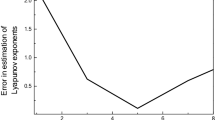Abstract.
Two different chaotic time series analysis methods – the correlation dimension and nonlinear forecasting – are introduced and then used to process the interspike intervals (ISI) of the action potential trains propagated along a single nerve fiber of the anesthetized rat. From the results, the conclusion is drawn that compared with the correlation dimension, nonlinear forecasting is more efficient and robust for chaotic ISI time series analysis in a noisy environment. Moreover, the evolution of the correlation coefficient curves calculated from nonlinear forecasting can qualitatively give a better reflection of the unpredictability of the system's future behavior and is in good agreement with the values of the largest Lyapunov exponent that quantitatively measures the degree of chaos.
Similar content being viewed by others
Author information
Authors and Affiliations
Additional information
Received: 19 November 1996 / Accepted in revised form: 15 September 1997
Rights and permissions
About this article
Cite this article
Yunfan, G., Jianxue, X., Wei, R. et al. Determining the degree of chaos from analysis of ISI time series in the nervous system: a comparison between correlation dimension and nonlinear forecasting methods. Biol Cybern 78, 159–165 (1998). https://doi.org/10.1007/s004220050422
Issue Date:
DOI: https://doi.org/10.1007/s004220050422




